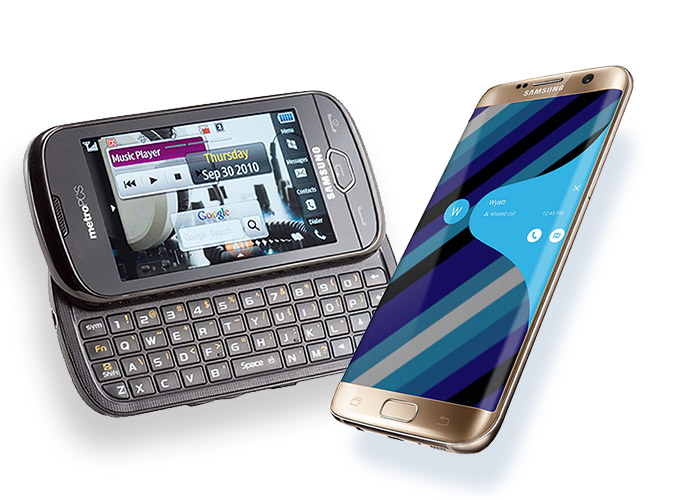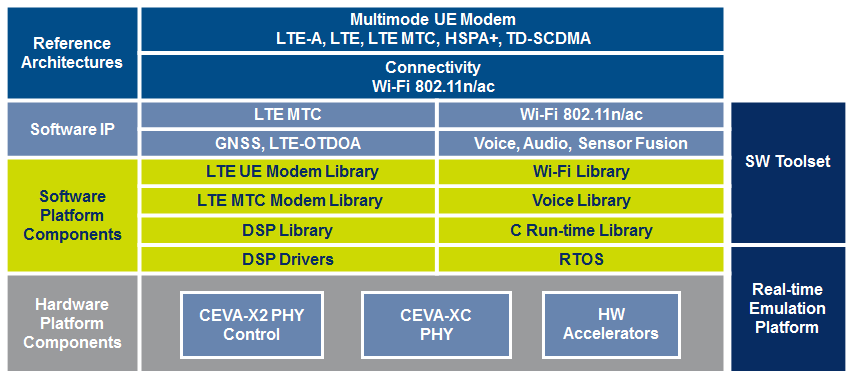Not many people realize, but the first ever LTE phone launched in the US was not powered by a Qualcomm DSP. In fact, the phone was powered by a CEVA DSP! When MetroPCS became the first 4G LTE carrier in the U.S. in September 2010, the first phone on the network was the Samsung Craft.

The 2010 Samsung Craft (the first ever LTE phone in the U.S.) and the 2016 Samsung Galaxy S7 – both powered by CEVA!
This smartphone was powered by a single-mode LTE chipset developed in-house by Samsung and used a CEVA DSP inside. And incidentally, the second modem chip in the phone to provide CDMA/EV-DO backwards compatibility was from VIA Telecom, and also powered by a CEVA DSP! Of course, over the next few years, Qualcomm quickly came to dominate the entire LTE landscape and it wasn’t until 2015 that we saw genuine competition back in the modem market again capable of displacing Qualcomm inside smartphones. One of the latest examples of which is the CEVA DSP powered Samsung Galaxy S7 lineup.
From 2010 until 2015, the wireless semiconductor landscape changed dramatically, with many of the stalwart wireless companies disappearing, shutting down or selling their assets. Companies such as ST-Ericsson, Broadcom, MStar, Marvell and RDA, all who were major suppliers in the wireless industry for 2G and 3G are now no more. These have been replaced by merchant vendors including Mediatek, Spreadtrum and Leadcore in Asia, and the return to internalized modem developments by OEMs such as Samsung, ZTE, Huawei and Xiaomi.
Today, the LTE era is fully underway around the world, with more than 1.3 billion subscribers and LTE smartphones as low as $50 in emerging markets. Our customers, including Samsung, Spreadtrum, Leadcore and Intel are all in mass market production with CEVA-powered LTE modems and rapidly gaining market share, worldwide. With more than 70 million CEVA-powered LTE smartphones shipped in 2015, and a target of 200 million for 2016, it’s clear that our customers are finally succeeding after many years of Qualcomm dominance in the LTE space.
So what’s next for LTE? And how is CEVA addressing this?
As has been well documented, the next two phases of LTE-A Pro Rel.13 and 5G are aimed at achieving two main goals: 1). To significantly increase data rates and overall capacity on the LTE networks, and 2) To support new use cases for the LTE networks, specifically to enable the Internet of Things to leverage LTE for connectivity.
From a DSP processing perspective, there are 3 different challenges that need to be addressed by the chip makers to make this a reality:
- Higher performance DSPs are required for the LTE infrastructure to displace the incumbent DSPs that have been around for decades. These are incapable of efficiently delivering the performance to cope with the demands of 5G.
- More efficient DSPs are required for LTE terminals to cope with the enormous processing challenges of multi-RAT and multi-carrier.
- New, ultra-low power DSPs are required to power a new generation of low-data rate LTE devices that will comprise the LTE-connected Internet of Things. These DSPs need to be capable of powering devices using extended sleep time that can sometimes last months and even years in the field using a single battery.
From these challenges, it is absolutely evident that DSP will play an even more central role in the future of our connected world. And utilizing the right DSP architecture for each task is absolutely critical. At CEVA, we are already strategically addressing these complex challenges with a whole range of LTE IPs, including scalar and vector DSPs, associated function-specific accelerators, optimized firmware and software reference chains.

The CEVA LTE IP offering, from DSPs all the way to software & reference architectures
Next week at the Linley Mobile and Wearables Conference, we will be presenting our LTE portfolio that addresses wearables all the way to LTE smartphones and computing devices. And part of this presentation will give a first look at our latest DSP for LTE, the CEVA-X2.
The CEVA-X2 is designed for specific LTE-Advanced-Pro and 5G use cases where the emphasis of the DSP is PHY control processing. For example, where the PHY Datapath tasks such as per-channel measurement and decoding are not required to run on the DSP, the CEVA-X2 offers a 30%-65% better die size efficiency and 10%-25% better power efficiency compared to CEVA-X4 DSP. The CEVA-X2 is also ideal to run both the PHY and MAC for a range of other communication standards, including IEEE 802.15.4g, ZigBee, Thread and power line communications (PLC), combining power efficiency with minimal die area and code size for such use cases.
To learn more about the CEVA-X2 and how we are helping to solve the processing challenges of next-generation LTE-Advanced Pro and 5G, join our presentation at the Linley Conference next week.

